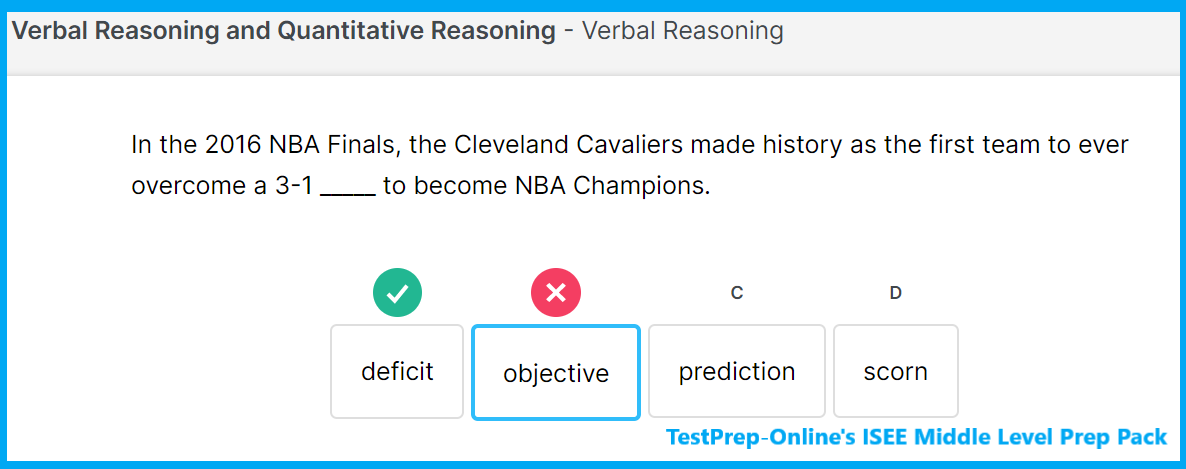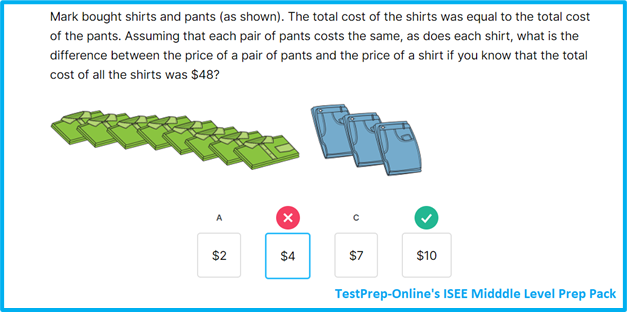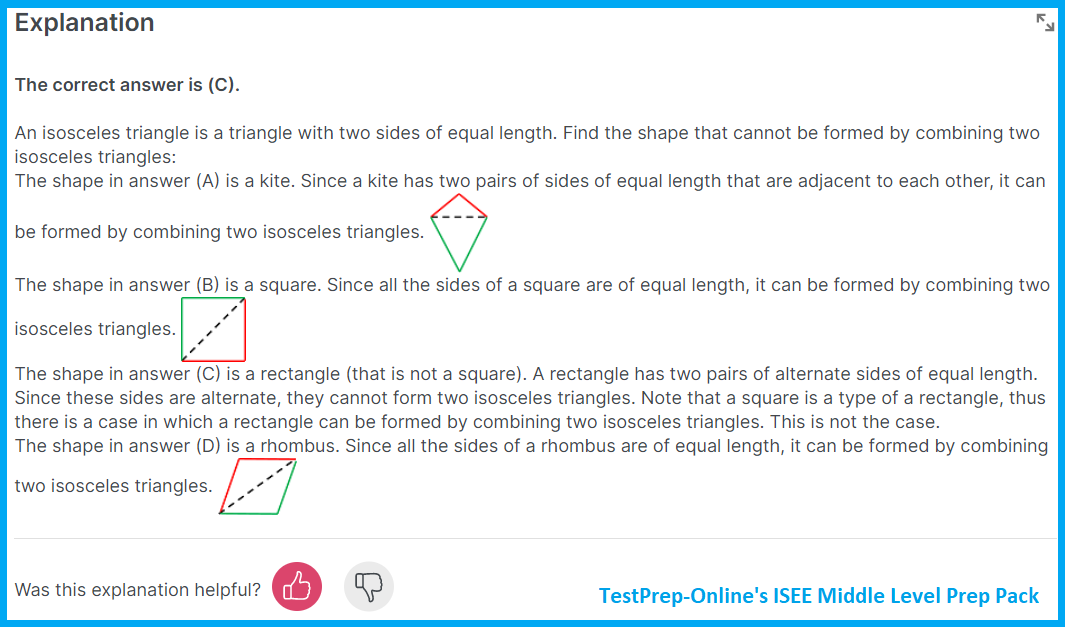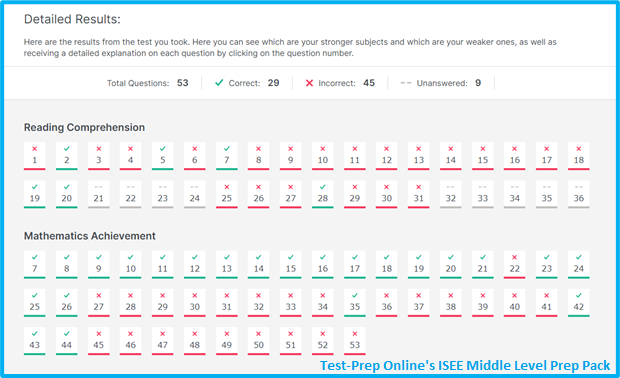Give Your Child the Competitive Edge They Need for Grades 6-8 Admissions
The ISEE Middle Level is more than just a test—it's your child's opportunity to showcase their academic potential to prestigious private schools. With only one chance to make a strong first impression, proper preparation isn't optional—it's essential.
Free ISEE Practice Questions - Middle Level
ISEE Middle Level Vocabulary Questions-Synonyms 1
The following question consists of a word in capital letters followed by four answer choices. Select
the one word that is most nearly the same in meaning as the word in capital letters
DIMINISH
TestPrep-Online Tutor's Tip:
"When I encounter the word DIMINISH, I think about the word 'dim' hidden inside it. Just like how lights can dim (become less bright), diminish means to become less of something. I also remember that diminish and reduce both have that sense of 'taking away' or 'making smaller.' If you're ever unsure, try using the word in a sentence: 'The sound began to diminish as we walked away' - you can easily substitute 'reduce' and it makes perfect sense!"
ISEE Middle Level Vocabulary Questions-Synonyms 2
The following question consists of a word in capital letters followed by four answer choices. Select
the one word that is most nearly the same in meaning as the word in capital letters
ABUNDANT
Get the Complete ISEE Middle Level Prep Pack Today!
Don't Leave Your Child's Future to Chance
Make it count with our comprehensive prep pack featuring hundreds of practice questions, expert tutor tips, and detailed explanations just like the samples above and below.
ISEE Middle Level Vocabulary Questions-Sentence Completion 1
Each blank indicates that a word is missing. The sentence is followed by four answer choices. Select the word that will best complete the meaning of the sentence as a whole.
Despite practicing for hours every day, Maria was still _______ about her upcoming piano recital.
TestPrep-Online Tutor's Tip:
"When I see contrast words like 'despite,' 'although,' 'however,' or 'but,' I know the sentence is setting up opposites. I ask myself: what would be the expected result of practicing for hours? That would make someone confident or prepared. So the answer has to be the opposite feeling - anxious or nervous. I always look for these signal words first because they tell me exactly what kind of relationship the sentence is building."
ISEE Middle Level Vocabulary Questions-Sentence Completion 2
Each blank indicates that a word is missing. The sentence is followed by four answer choices. Select the word that will best complete the meaning of the sentence as a whole.
The scientist's _______ explanation helped the students understand the complex experiment that had previously confused them.
TestPrep-Online Tutor's Tip:
"I focus on cause and effect in these sentences. The effect is that 'students understood' something that 'previously confused them.' So I need to find what quality of an explanation would cause confused students to suddenly understand. Clear explanations help people understand difficult concepts - that's the direct cause-and-effect relationship. I also notice that 'complex experiment' and 'confused' are clues that we need something that makes difficult things easier to grasp."
ISEE Middle Level Quantitative Reasoning Questions 1
Using the information given in each question, compare the quantity in Column A to the quantity in Column B. All questions have these answer choices:
(A) The quantity in Column A is greater.
(B) The quantity in Column B is greater.
(C) The two quantities are equal.
(D) The relationship cannot be determined from the information given.
| Column A | Column B |
| 3/4 of 80 | 80% of 75 |
TestPrep-Online Tutor's Tip:
"When I see fractions and percentages being compared, I always convert everything to the same form to make the comparison easier. I could convert 3/4 to 75% (which is 75/100), or convert 80% to a fraction (4/5). But often the easiest approach is just to calculate both values as decimals. I also look for patterns - notice that 3/4 = 0.75 and we're taking 0.75 of a number that's slightly bigger than the other base number, while 80% = 0.8 and we're taking 0.8 of a slightly smaller base. Sometimes these balance out perfectly!"
ISEE Middle Level Quantitative Reasoning Questions 2
Using the information given in each question, compare the quantity in Column A to the quantity in Column B. All questions have these answer choices:
(A) The quantity in Column A is greater.
(B) The quantity in Column B is greater.
(C) The two quantities are equal.
(D) The relationship cannot be determined from the information given.
x is a positive integer
| Column A | Column B |
| 2x + 5 | 3x + 1 |
Transform Your Child from Test-Anxious to Test-Ready in Just 30 Days
See how our sample questions helped students master vocabulary, quantitative reasoning, and reading comprehension? Our complete ISEE Middle Level prep pack contains practice materials, all crafted by test experts who know exactly what admissions committees want to see. Don't just practice—practice with purpose.
ISEE Middle Level Mathematics Achievement Questions 1
Of the 60% of students who brought lunch to school, 3/4 also brought a drink. What fraction of all students brought both lunch and a drink?
ISEE Middle Level Mathematics Achievement Questions 2
What is the value of x in the equation 2 1/4 + 1 5/6 = x?
TestPrep-Online Tutor's Tip:
"When adding mixed numbers, I always find the LCD (Least Common Denominator) of the fractions first. For 4 and 6, I think: what's the smallest number both 4 and 6 divide into? I can use the multiplication method: 4 × 6 = 24, but I know 12 works too since 4 × 3 = 12 and 6 × 2 = 12. Always use the smaller LCD to make calculations easier. Then I convert each fraction: 1/4 = ?/12 means 1/4 = 3/12 (multiply top and bottom by 3). For 5/6 = ?/12, I multiply top and bottom by 2 to get 10/12. When my fraction answer is improper (like 13/12), I convert it back to a mixed number and add it to my whole number sum."
The following 3 questions are based on the passage below
The Secret Life of Urban Wildlife
Many people believe that cities are concrete jungles where wildlife cannot survive. However, this assumption is completely wrong. Urban environments actually provide unique opportunities for many animal species to thrive in ways they never could in the wild.
Cities offer abundant food sources that attract various creatures. Raccoons have learned to open garbage cans with remarkable dexterity, while pigeons feast on dropped food scraps. Rats navigate subway tunnels like underground highways, and urban hawks hunt from skyscrapers instead of cliff faces. These animals have developed extraordinary adaptability to city life.
The metamorphosis of animal behavior in urban settings is truly fascinating. Coyotes have learned to time their movements with traffic patterns, avoiding busy streets during rush hour. Some bird species sing louder and at different frequencies to communicate over city noise. Urban foxes have become more nocturnal than their rural cousins, emerging only when human activity decreases.
Cities also provide unexpected shelter options. Birds nest in traffic lights and building ledges. Bats roost under bridges, while urban deer create trails through parks and residential areas. Even large predators like mountain lions occasionally wander into suburban neighborhoods, following natural corridors that connect urban areas to wilderness.
However, urban wildlife faces unique challenges. Light pollution disrupts natural sleep cycles, while vehicle traffic poses constant dangers. Chemical runoff from streets contaminate water sources, and habitat fragmentation forces animals into smaller territories.
Despite these obstacles, urban wildlife populations continue to grow. Scientists estimate that cities now support more biodiversity than many natural habitats. This remarkable adaptation demonstrates nature's incredible resilience and creativity in the face of human development. Urban wildlife proves that the boundary between civilization and nature is far more blurred than we once believed.
ISEE Middle Level Reading Comprehension Qustion 1
One of the main purposes of the passage is to explain...
TestPrep-Online Tutor's Tip:
"When identifying the main purpose, look for the thesis statement (usually in the first paragraph) and see how the rest of the passage supports that central idea."
ISEE Middle Level Reading Comprehension Qustion 2
Which best describes the organization of the passage?
TestPrep-Online Tutor's Tip:
"Pay attention to transition words like "However" that signal the author is challenging or contrasting with a previous statement. This often indicates the organizational pattern"
ISEE Middle Level Reading Comprehension Qustion 3
In the passage, the word "metamorphosis" most likely means:
TestPrep-Online Tutor's Tip:
"When encountering unfamiliar vocabulary, look at the context - the examples and explanations around the word often provide clues to its meaning. Also, think about any related words you might know (like "morph" meaning to change)."
The sample questions above are just the beginning. Our full ISEE Middle Level prep pack delivers everything your child needs to walk into test day with unshakeable confidence and the skills to excel.
FAQs
Most students see significant improvement with 4-6 weeks of consistent practice (30-45 minutes daily). However, the beauty of our digital pack is that your child can work at their own pace. Some students benefit from 8+ weeks of preparation, while others who are strong test-takers may need just 2-3 weeks of focused review.
Yes! While the essay portion isn't scored, it is sent to schools and can influence admission decisions. Our prep pack includes essay prompts similar to those on the actual test, along with sample responses and scoring guidelines to help your child craft compelling, well-structured essays.
Immediately! Once you complete your purchase, you'll receive instant access to all materials. Your child can begin practicing within minutes of ordering. All materials are available online 24/7, so your child can study whenever it's most convenient.
This prep pack is specifically designed for students in grades 5-7 who are taking the ISEE Middle Level exam for admission to grades 6-8. The content difficulty and question types are carefully calibrated to match what these grade levels encounter on the actual test.
What to Expect on the ISEE Middle Level
The Middle Level ISEE contains a total of 160 multiple choice questions, divided into four sections, each examining different sets of skills. Additionally, there is a fifth section in which the applicants are required to draft an essay.
The Verbal Reasoning section is designed to test the students’ vocabulary skills. This section contains 40 questions divided into two categories: synonym questions, which test the ability to recognize connections between words with similar meanings, and sentence completion questions, which test the ability to understand word functions in context.

The Quantitative Reasoning section is designed to test the students’ ability to think mathematically. This section is comprised of 37 questions, including word problems and quantitative comparison questions.

The Reading Comprehension section is designed to test the students’ ability to understand and properly analyze a given text. This section contains six passages, each followed by six questions, for a total of 36 questions. These questions are meant to examine different aspects of reading comprehension, including main and supporting ideas, inferences, vocabulary, organization and logic, and style and tone.
The Mathematics Achievement section is designed to test knowledge of math processes and terminology learned in past school years. Unlike the quantitative reasoning section, this section requires the students to make actual calculations and use mathematical skills. This section contains 47 questions of various mathematical topics, including number operations, geometry, algebra, measurement, data analysis & probability, and problem-solving.

The Essay section is designed to test the students' ability to describe ideas, make personal reflections, and organize thoughts. Moreover, the essay gives the admissions office insight into more personal aspects of the applicants. In this section, the student is required to write a short essay in response to an essay prompt that is selected randomly from various topics pertaining to the interests of students their age and gives students the chance to write about themselves.
While each ISEE level consists of the same question types, the ISEE Middle Level is geared toward kids in the 6th and 7th grade. It is a bit longer than the ISEE Lower Level and the same length as the ISEE Upper Level. The questions on the test reflect the expected knowledge level of this age group.

Upon finishing each practice exam, your child can review his or her test using a detailed score report that shows which questions were answered incorrectly, the number of correct answers, and the total score.
Additionally, he or she can read full explanations for each question. If a question has been answered incorrectly, the explanation can be used to understand what was done wrong and how to correctly solve that question. If a question has been answered correctly, the explanation can help introduce your child to new methods and approaches for solving those types of questions.

With this report, you will be able to identify your child’s strengths and weaknesses, and you can use this knowledge to determine where to concentrate your efforts in helping him or her become fully prepared in all of the various topics on the test.
Help your child prepare for the ISEE Middle Level with TestPrep-Online so that he or she will be fully ready and confident in their abilities on the day of the test!
If you looking the SSAT placement test, click here!
ISEE Online Test Prep
Preparing properly for the ISEE Middle Level is crucial to obtaining the highest results possible. As schools are comparing applicants' accomplishments on this test to determine their qualification, a high ISEE score can have a significant impact on your child's probability of being accepted.
TestPrep-Online offers level-specific, child-friendly ISEE practice test packs to help ensure your child is well prepared for test day. The Premium ISEE Middle Level Practice Test Pack includes two full-length, realistic practice tests that each simulating the actual ISEE test, thus enabling your child to become familiar with the test’s unique structure.



